Organizational Change: Leading & Managing - Report and Analysis
VerifiedAdded on 2022/09/10
|8
|1187
|21
Report
AI Summary
This report provides a comprehensive analysis of leading and managing organizational change. It begins by identifying strategic change needs through the review of existing policies, practices, and the external environment, including competitors and government policies. The report then outlines the design and development of a simple project, emphasizing customer relationships, risk analysis, and mitigation strategies. A detailed change management project plan is developed, covering stakeholder engagement, communication strategies, and approval processes. The report also focuses on communication development, including techniques to promote the benefits of change and address barriers. Finally, the report explores action interventions, strategies for embedding change, and regular evaluation and modification of the project plan to achieve change program objectives. The report includes references to support the analysis.
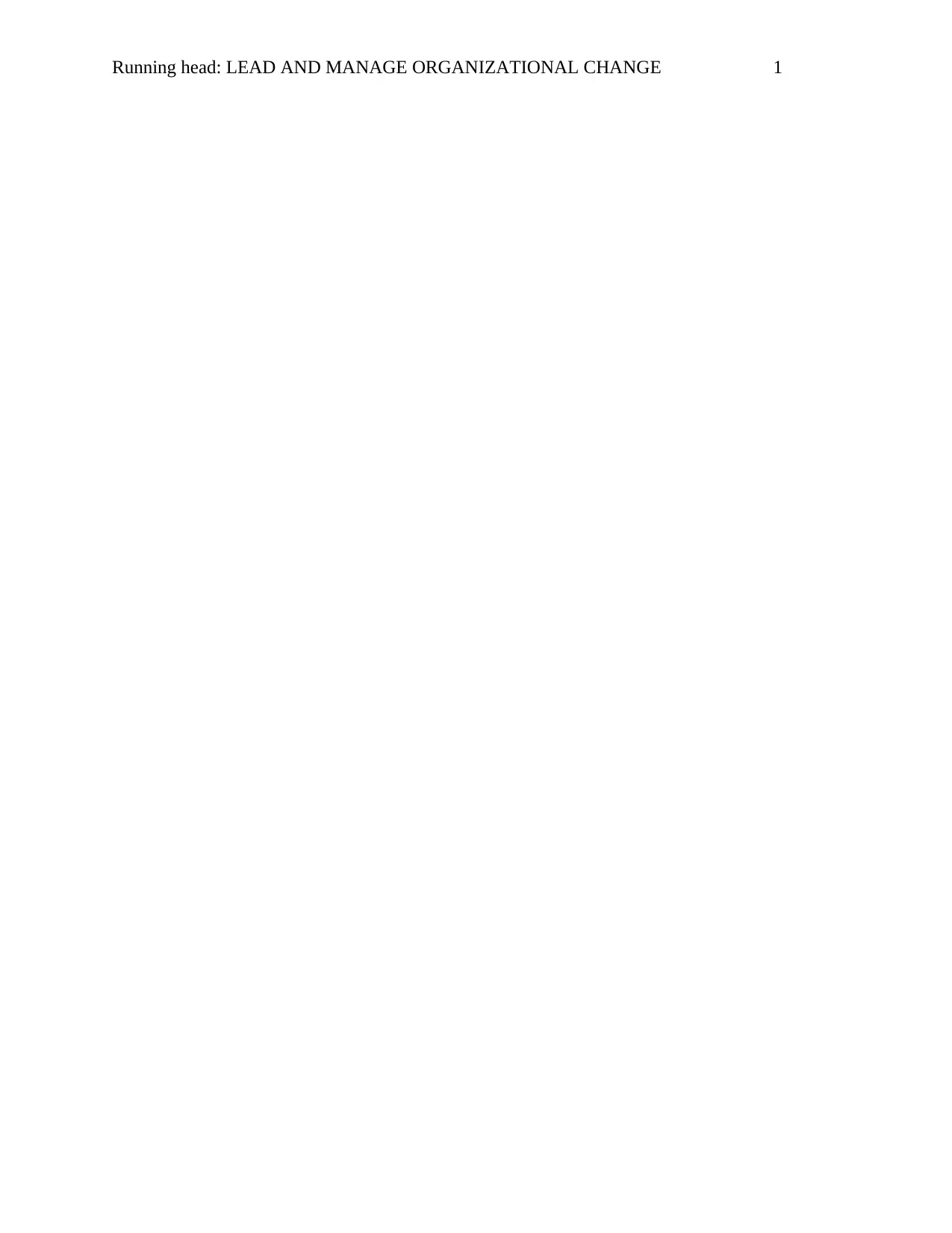
Running head: LEAD AND MANAGE ORGANIZATIONAL CHANGE 1
Paraphrase This Document
Need a fresh take? Get an instant paraphrase of this document with our AI Paraphraser
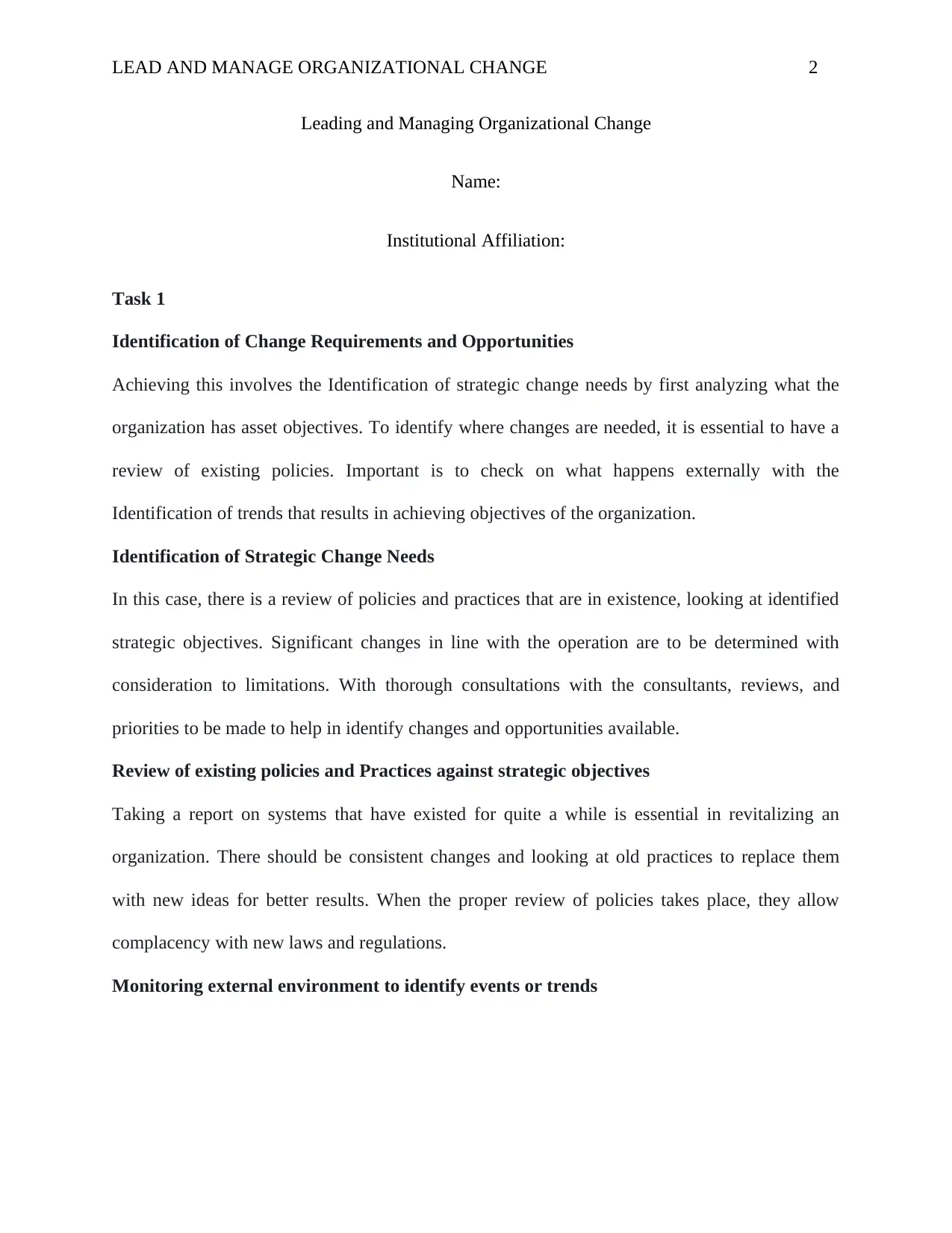
LEAD AND MANAGE ORGANIZATIONAL CHANGE 2
Leading and Managing Organizational Change
Name:
Institutional Affiliation:
Task 1
Identification of Change Requirements and Opportunities
Achieving this involves the Identification of strategic change needs by first analyzing what the
organization has asset objectives. To identify where changes are needed, it is essential to have a
review of existing policies. Important is to check on what happens externally with the
Identification of trends that results in achieving objectives of the organization.
Identification of Strategic Change Needs
In this case, there is a review of policies and practices that are in existence, looking at identified
strategic objectives. Significant changes in line with the operation are to be determined with
consideration to limitations. With thorough consultations with the consultants, reviews, and
priorities to be made to help in identify changes and opportunities available.
Review of existing policies and Practices against strategic objectives
Taking a report on systems that have existed for quite a while is essential in revitalizing an
organization. There should be consistent changes and looking at old practices to replace them
with new ideas for better results. When the proper review of policies takes place, they allow
complacency with new laws and regulations.
Monitoring external environment to identify events or trends
Leading and Managing Organizational Change
Name:
Institutional Affiliation:
Task 1
Identification of Change Requirements and Opportunities
Achieving this involves the Identification of strategic change needs by first analyzing what the
organization has asset objectives. To identify where changes are needed, it is essential to have a
review of existing policies. Important is to check on what happens externally with the
Identification of trends that results in achieving objectives of the organization.
Identification of Strategic Change Needs
In this case, there is a review of policies and practices that are in existence, looking at identified
strategic objectives. Significant changes in line with the operation are to be determined with
consideration to limitations. With thorough consultations with the consultants, reviews, and
priorities to be made to help in identify changes and opportunities available.
Review of existing policies and Practices against strategic objectives
Taking a report on systems that have existed for quite a while is essential in revitalizing an
organization. There should be consistent changes and looking at old practices to replace them
with new ideas for better results. When the proper review of policies takes place, they allow
complacency with new laws and regulations.
Monitoring external environment to identify events or trends
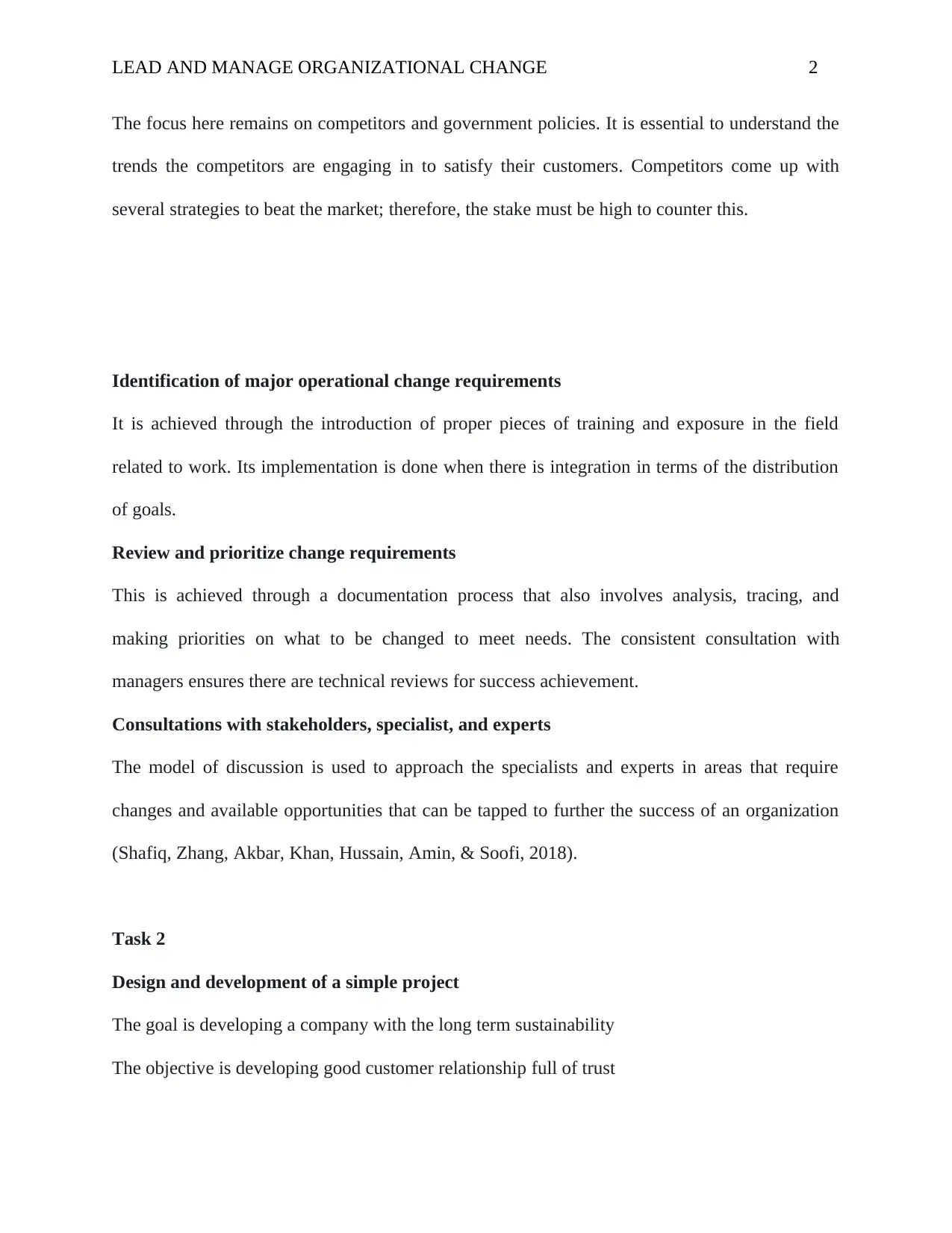
LEAD AND MANAGE ORGANIZATIONAL CHANGE 2
The focus here remains on competitors and government policies. It is essential to understand the
trends the competitors are engaging in to satisfy their customers. Competitors come up with
several strategies to beat the market; therefore, the stake must be high to counter this.
Identification of major operational change requirements
It is achieved through the introduction of proper pieces of training and exposure in the field
related to work. Its implementation is done when there is integration in terms of the distribution
of goals.
Review and prioritize change requirements
This is achieved through a documentation process that also involves analysis, tracing, and
making priorities on what to be changed to meet needs. The consistent consultation with
managers ensures there are technical reviews for success achievement.
Consultations with stakeholders, specialist, and experts
The model of discussion is used to approach the specialists and experts in areas that require
changes and available opportunities that can be tapped to further the success of an organization
(Shafiq, Zhang, Akbar, Khan, Hussain, Amin, & Soofi, 2018).
Task 2
Design and development of a simple project
The goal is developing a company with the long term sustainability
The objective is developing good customer relationship full of trust
The focus here remains on competitors and government policies. It is essential to understand the
trends the competitors are engaging in to satisfy their customers. Competitors come up with
several strategies to beat the market; therefore, the stake must be high to counter this.
Identification of major operational change requirements
It is achieved through the introduction of proper pieces of training and exposure in the field
related to work. Its implementation is done when there is integration in terms of the distribution
of goals.
Review and prioritize change requirements
This is achieved through a documentation process that also involves analysis, tracing, and
making priorities on what to be changed to meet needs. The consistent consultation with
managers ensures there are technical reviews for success achievement.
Consultations with stakeholders, specialist, and experts
The model of discussion is used to approach the specialists and experts in areas that require
changes and available opportunities that can be tapped to further the success of an organization
(Shafiq, Zhang, Akbar, Khan, Hussain, Amin, & Soofi, 2018).
Task 2
Design and development of a simple project
The goal is developing a company with the long term sustainability
The objective is developing good customer relationship full of trust
⊘ This is a preview!⊘
Do you want full access?
Subscribe today to unlock all pages.

Trusted by 1+ million students worldwide
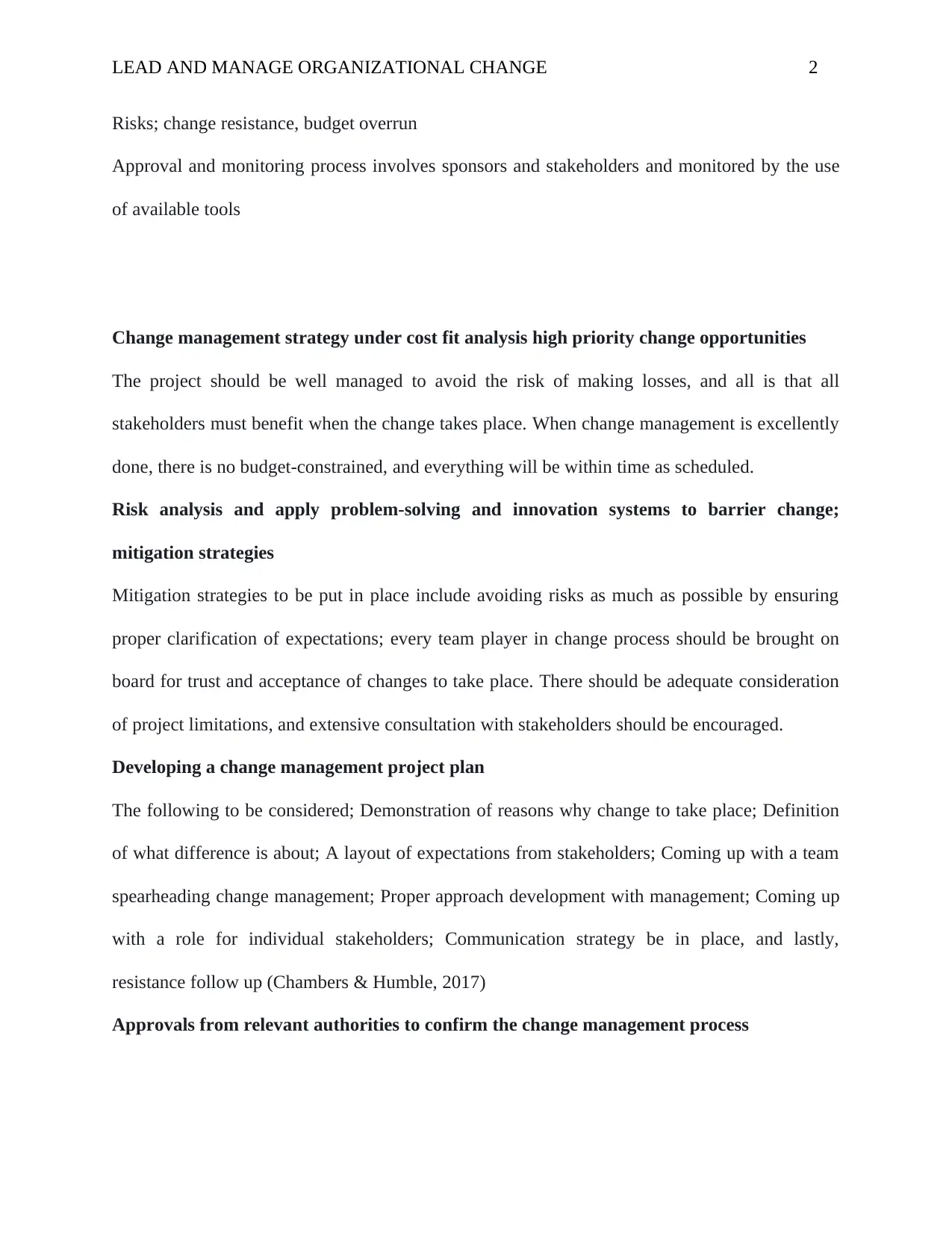
LEAD AND MANAGE ORGANIZATIONAL CHANGE 2
Risks; change resistance, budget overrun
Approval and monitoring process involves sponsors and stakeholders and monitored by the use
of available tools
Change management strategy under cost fit analysis high priority change opportunities
The project should be well managed to avoid the risk of making losses, and all is that all
stakeholders must benefit when the change takes place. When change management is excellently
done, there is no budget-constrained, and everything will be within time as scheduled.
Risk analysis and apply problem-solving and innovation systems to barrier change;
mitigation strategies
Mitigation strategies to be put in place include avoiding risks as much as possible by ensuring
proper clarification of expectations; every team player in change process should be brought on
board for trust and acceptance of changes to take place. There should be adequate consideration
of project limitations, and extensive consultation with stakeholders should be encouraged.
Developing a change management project plan
The following to be considered; Demonstration of reasons why change to take place; Definition
of what difference is about; A layout of expectations from stakeholders; Coming up with a team
spearheading change management; Proper approach development with management; Coming up
with a role for individual stakeholders; Communication strategy be in place, and lastly,
resistance follow up (Chambers & Humble, 2017)
Approvals from relevant authorities to confirm the change management process
Risks; change resistance, budget overrun
Approval and monitoring process involves sponsors and stakeholders and monitored by the use
of available tools
Change management strategy under cost fit analysis high priority change opportunities
The project should be well managed to avoid the risk of making losses, and all is that all
stakeholders must benefit when the change takes place. When change management is excellently
done, there is no budget-constrained, and everything will be within time as scheduled.
Risk analysis and apply problem-solving and innovation systems to barrier change;
mitigation strategies
Mitigation strategies to be put in place include avoiding risks as much as possible by ensuring
proper clarification of expectations; every team player in change process should be brought on
board for trust and acceptance of changes to take place. There should be adequate consideration
of project limitations, and extensive consultation with stakeholders should be encouraged.
Developing a change management project plan
The following to be considered; Demonstration of reasons why change to take place; Definition
of what difference is about; A layout of expectations from stakeholders; Coming up with a team
spearheading change management; Proper approach development with management; Coming up
with a role for individual stakeholders; Communication strategy be in place, and lastly,
resistance follow up (Chambers & Humble, 2017)
Approvals from relevant authorities to confirm the change management process
Paraphrase This Document
Need a fresh take? Get an instant paraphrase of this document with our AI Paraphraser
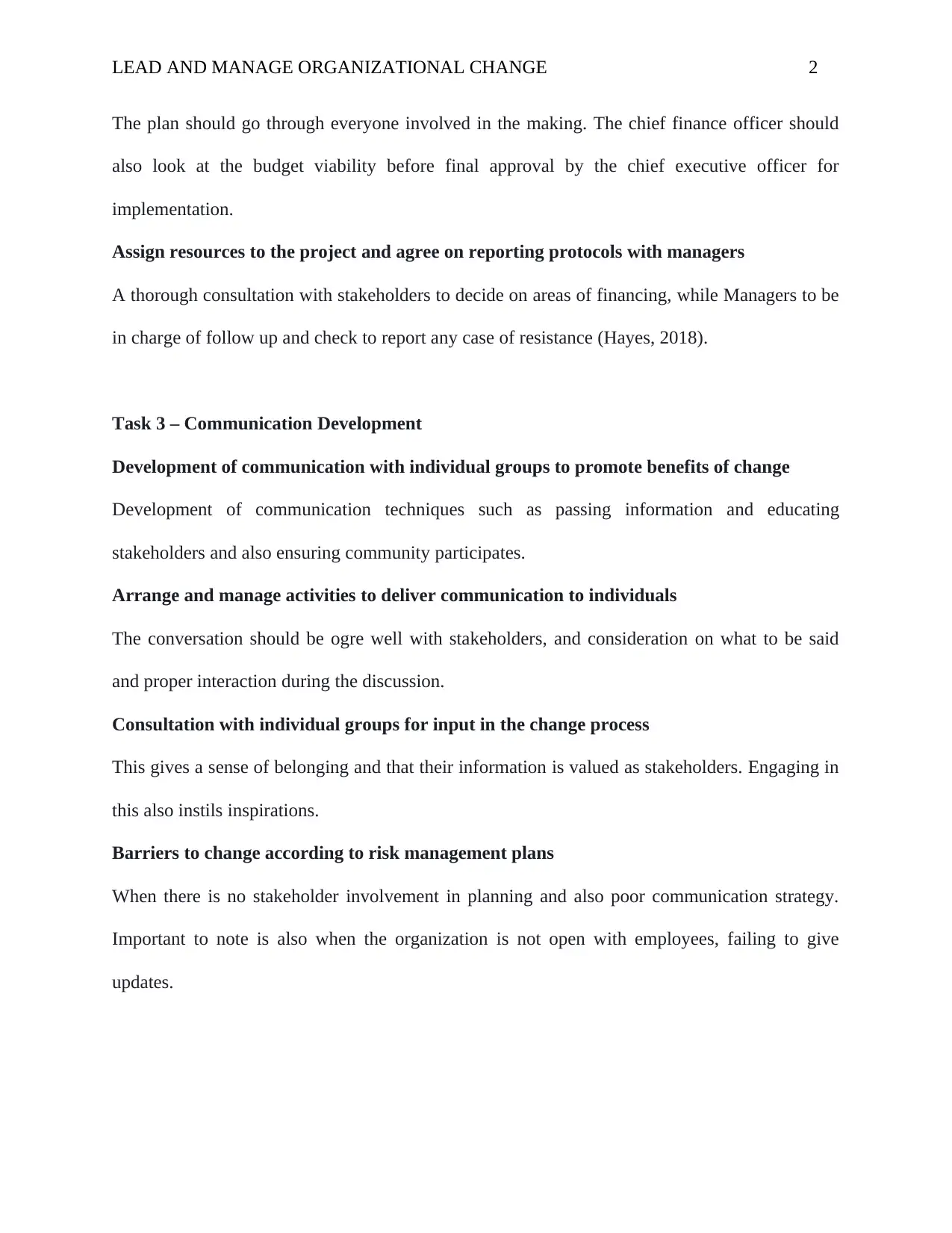
LEAD AND MANAGE ORGANIZATIONAL CHANGE 2
The plan should go through everyone involved in the making. The chief finance officer should
also look at the budget viability before final approval by the chief executive officer for
implementation.
Assign resources to the project and agree on reporting protocols with managers
A thorough consultation with stakeholders to decide on areas of financing, while Managers to be
in charge of follow up and check to report any case of resistance (Hayes, 2018).
Task 3 – Communication Development
Development of communication with individual groups to promote benefits of change
Development of communication techniques such as passing information and educating
stakeholders and also ensuring community participates.
Arrange and manage activities to deliver communication to individuals
The conversation should be ogre well with stakeholders, and consideration on what to be said
and proper interaction during the discussion.
Consultation with individual groups for input in the change process
This gives a sense of belonging and that their information is valued as stakeholders. Engaging in
this also instils inspirations.
Barriers to change according to risk management plans
When there is no stakeholder involvement in planning and also poor communication strategy.
Important to note is also when the organization is not open with employees, failing to give
updates.
The plan should go through everyone involved in the making. The chief finance officer should
also look at the budget viability before final approval by the chief executive officer for
implementation.
Assign resources to the project and agree on reporting protocols with managers
A thorough consultation with stakeholders to decide on areas of financing, while Managers to be
in charge of follow up and check to report any case of resistance (Hayes, 2018).
Task 3 – Communication Development
Development of communication with individual groups to promote benefits of change
Development of communication techniques such as passing information and educating
stakeholders and also ensuring community participates.
Arrange and manage activities to deliver communication to individuals
The conversation should be ogre well with stakeholders, and consideration on what to be said
and proper interaction during the discussion.
Consultation with individual groups for input in the change process
This gives a sense of belonging and that their information is valued as stakeholders. Engaging in
this also instils inspirations.
Barriers to change according to risk management plans
When there is no stakeholder involvement in planning and also poor communication strategy.
Important to note is also when the organization is not open with employees, failing to give
updates.
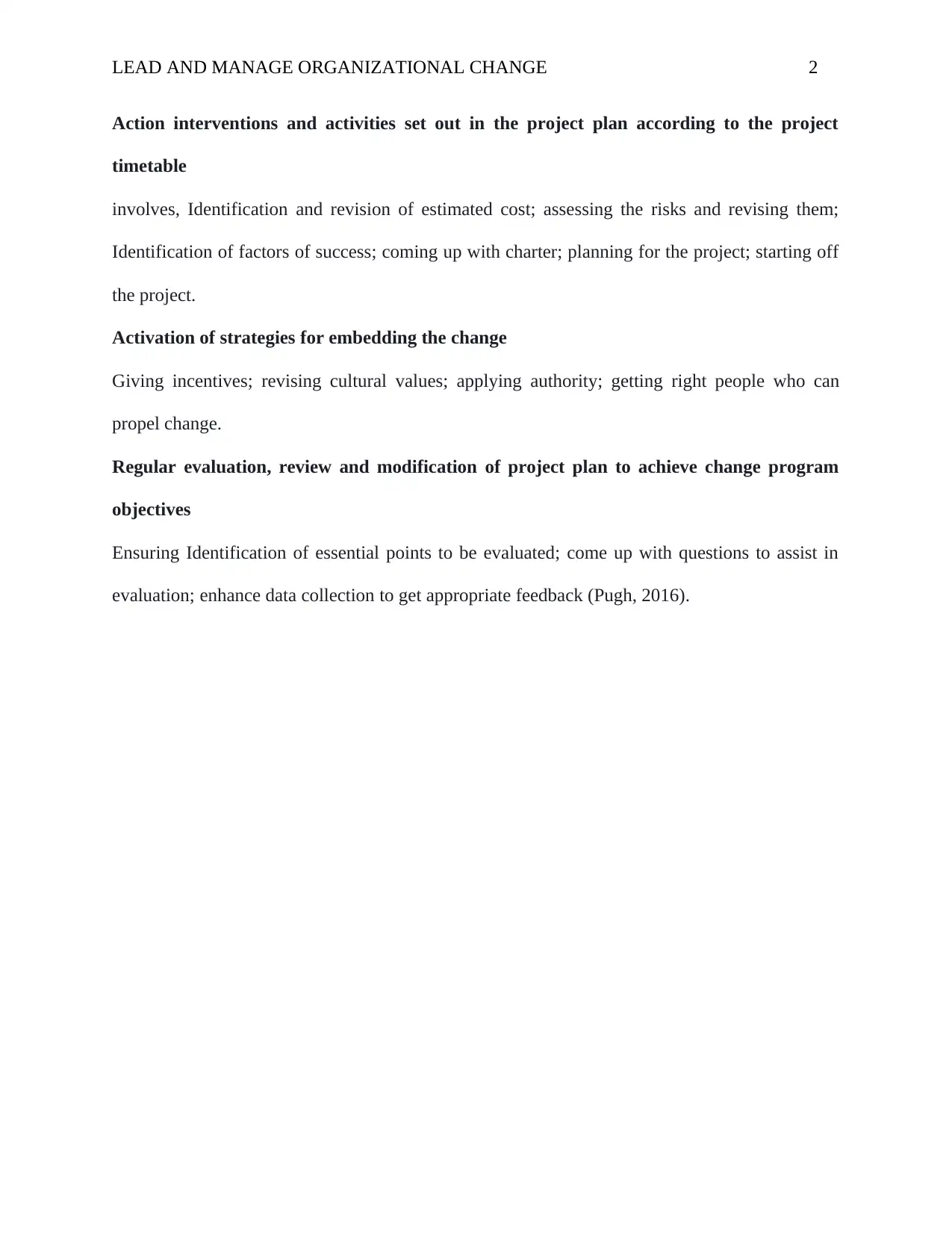
LEAD AND MANAGE ORGANIZATIONAL CHANGE 2
Action interventions and activities set out in the project plan according to the project
timetable
involves, Identification and revision of estimated cost; assessing the risks and revising them;
Identification of factors of success; coming up with charter; planning for the project; starting off
the project.
Activation of strategies for embedding the change
Giving incentives; revising cultural values; applying authority; getting right people who can
propel change.
Regular evaluation, review and modification of project plan to achieve change program
objectives
Ensuring Identification of essential points to be evaluated; come up with questions to assist in
evaluation; enhance data collection to get appropriate feedback (Pugh, 2016).
Action interventions and activities set out in the project plan according to the project
timetable
involves, Identification and revision of estimated cost; assessing the risks and revising them;
Identification of factors of success; coming up with charter; planning for the project; starting off
the project.
Activation of strategies for embedding the change
Giving incentives; revising cultural values; applying authority; getting right people who can
propel change.
Regular evaluation, review and modification of project plan to achieve change program
objectives
Ensuring Identification of essential points to be evaluated; come up with questions to assist in
evaluation; enhance data collection to get appropriate feedback (Pugh, 2016).
⊘ This is a preview!⊘
Do you want full access?
Subscribe today to unlock all pages.

Trusted by 1+ million students worldwide
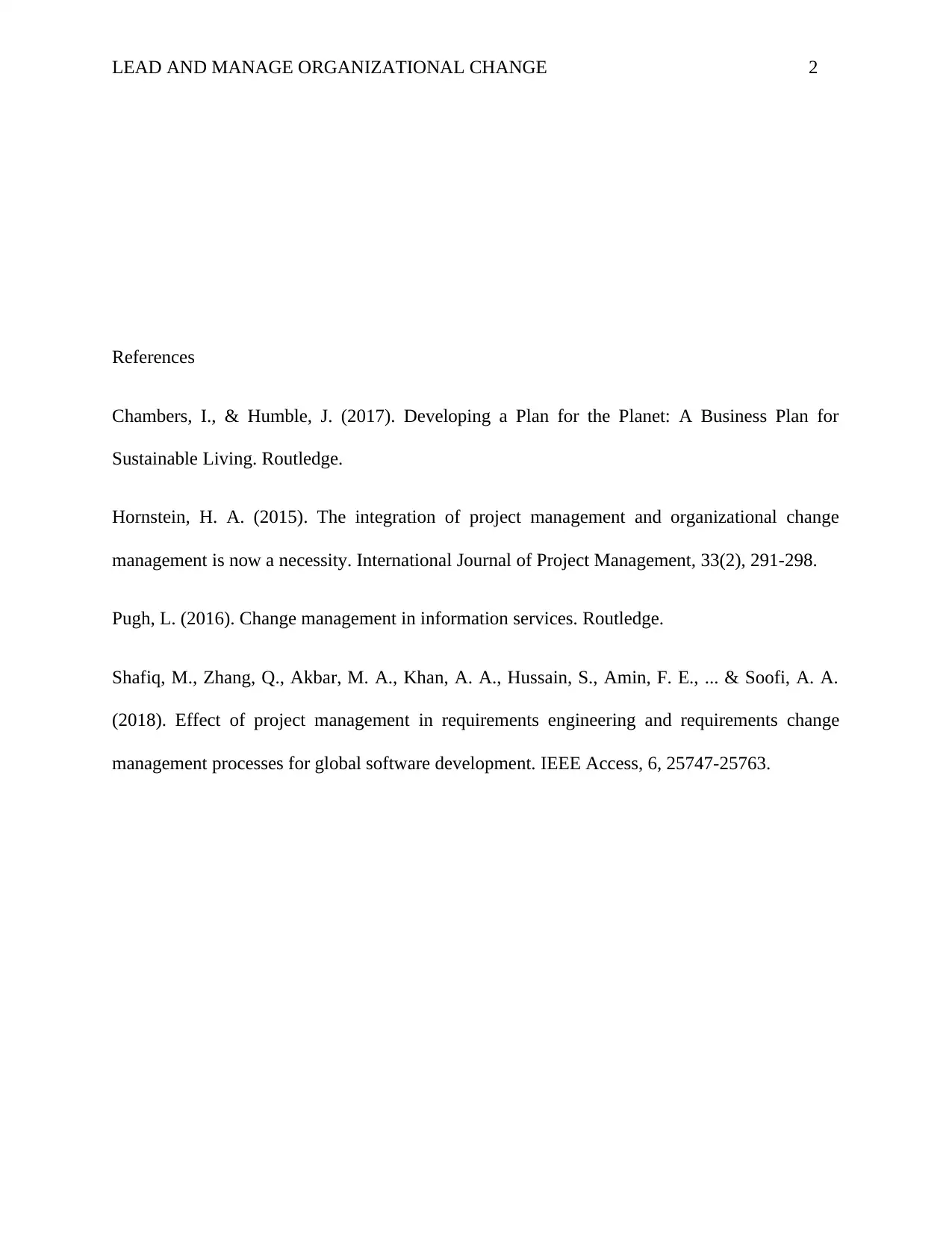
LEAD AND MANAGE ORGANIZATIONAL CHANGE 2
References
Chambers, I., & Humble, J. (2017). Developing a Plan for the Planet: A Business Plan for
Sustainable Living. Routledge.
Hornstein, H. A. (2015). The integration of project management and organizational change
management is now a necessity. International Journal of Project Management, 33(2), 291-298.
Pugh, L. (2016). Change management in information services. Routledge.
Shafiq, M., Zhang, Q., Akbar, M. A., Khan, A. A., Hussain, S., Amin, F. E., ... & Soofi, A. A.
(2018). Effect of project management in requirements engineering and requirements change
management processes for global software development. IEEE Access, 6, 25747-25763.
References
Chambers, I., & Humble, J. (2017). Developing a Plan for the Planet: A Business Plan for
Sustainable Living. Routledge.
Hornstein, H. A. (2015). The integration of project management and organizational change
management is now a necessity. International Journal of Project Management, 33(2), 291-298.
Pugh, L. (2016). Change management in information services. Routledge.
Shafiq, M., Zhang, Q., Akbar, M. A., Khan, A. A., Hussain, S., Amin, F. E., ... & Soofi, A. A.
(2018). Effect of project management in requirements engineering and requirements change
management processes for global software development. IEEE Access, 6, 25747-25763.
Paraphrase This Document
Need a fresh take? Get an instant paraphrase of this document with our AI Paraphraser

LEAD AND MANAGE ORGANIZATIONAL CHANGE 2
1 out of 8
Related Documents
Your All-in-One AI-Powered Toolkit for Academic Success.
+13062052269
info@desklib.com
Available 24*7 on WhatsApp / Email
![[object Object]](/_next/static/media/star-bottom.7253800d.svg)
Unlock your academic potential
Copyright © 2020–2025 A2Z Services. All Rights Reserved. Developed and managed by ZUCOL.



